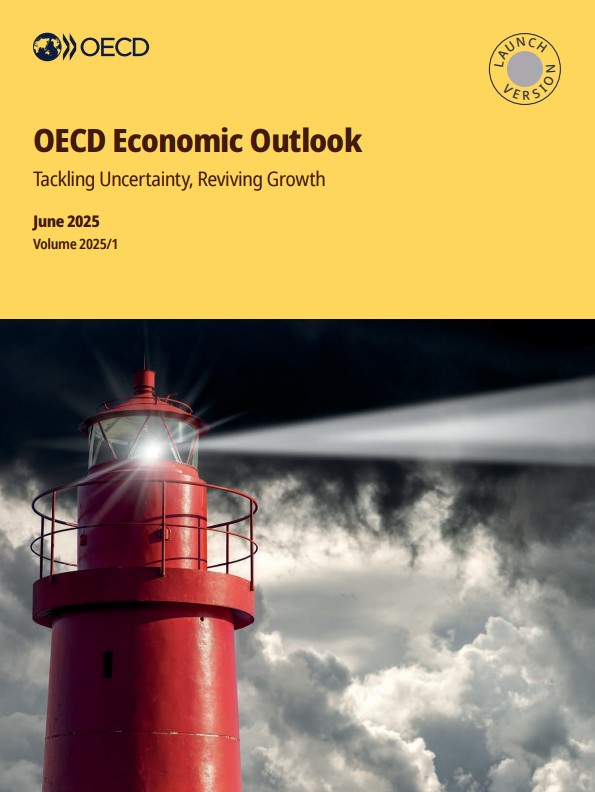□ 경제협력개발기구는 세계경제가 더 어려워지고 있다(becoming increasingly challenging)고 진단하며 향후 세계경제 성장률은 '25년 2.9%('25.3월 전망 대비 △0.2%p), '26년 2.9%(△0.1%p)로 둔화(slow)될 것으로 전망함
ㅇ 무역장벽 확대, 금융 여건 악화, 기업·소비자 심리 약화, 정책 불확실성 확대 등이 지속될 경우 성장에 악영향을 미칠 수 있다고 언급함
ㅇ 성장 둔화는 미국·캐나다·멕시코등에 집중될 것이라고 언급함
ㅇ ▲미국은 실효 관세율상승, 무역 상대국의 보복조치 등으로 성장이 상당히 둔화(slow significantly)되며 '25년 1.6%, '26년 1.5% 성장이 전망됨. ▲일본은 소비·투자 증가가 대외수요 감소로 상쇄되며 '25년 0.7%, '26년 0.4% 성장이 전망됨. ▲유로존은 지속적인 자본지출, 회복력 있는 노동시장 등이 무역 갈등 영향을 상쇄하며, '25년 1.0%, '26년
1.2% 성장이 전망됨. ▲중국은 관세 인상 등 영향으로 성장이 둔화되나, 재정 부양책이 이를 일부 완화하며 '25년 4.7%, '26년 4.3% 성장이 전망됨
ㅇ 경제협력개발기구는 세계경제 성장의 하방요인으로 ①무역장벽 강화 또는 급격한 변화, ②기대인플레이션 상승에 따른 인플레이션 압력 장기화, ③위험자산
재조정(risk repricing) 과정에서 금융시장 불안 촉발 우려 등을 지적함. 상방요인으로는 무역장벽 완화(reversal of the increase in trade barriers) 등을 언급함
□ 한국경제의 경우, 관세 및 대외 불확실성이 수출·투자를 제약하는 한편, 민간소비는 정치적 불확실성 완화 및 실질임금 상승에 힘입어 '25년 후반 이후 회복을 예상함.
ㅇ 성장률은 '25년 1.0%('25.3월 전망 대비 △0.5%p)로 전년 대비 하락한 후, '26년은 2.2%('25.3월 전망과 동일)로 회복을 전망함.
ㅇ 물가상승률은 목표치에 근접한 수준인 '25년 2.1%('25.3월 전망 대비 +0.2%p), '26년 2.0%(△0.1%p)로 전망함
ㅇ 정책권고의 경우, 단기적으로 재정지원이 적절할 수 있으나, 지속가능한 장기 재정운용체계(framework) 마련이 병행되어야 한다고 조언함. 통화정책은내수 부진을 고려해 추가적인 완화(monetary policy loosening is warranted)를 권고함. 한편, 노동시장 개혁을 통해 성장을 촉진하고 노인 빈곤을 완화하며출산·육아(motherhood)에 따른 기회비용을 축소할 수 있다고 언급함
[출처] [보도참고] 경제협력개발기구, 6월 경제전망 발표 (2025.06.03.) / 기획재정부 보도자료
목차
Acknowledgements 7
Editorial Tackling uncertainty, reviving growth 9
1. General assessment of the macroeconomic situation 11
Introduction 11
Recent Developments 13
Projections 27
Risks 33
Policies 43
References 60
Annex 1.A. Policy and other assumptions underlying the projections 64
2. Reigniting investment for more resilient growth 65
Summary 65
A prolonged period of weak investment has weighed on potential output growth 65
Business investment has been held back by subdued demand, elevated uncertainty and structural factors 68
Housing investment has fallen short of demand, reducing affordability 83
Public investment has picked up but remains below pre-GFC levels 84
Public policy reforms can help reinvigorate investment 85
References 95
Annex 2.A. An investment accelerator model 100
3. Developments in individual OECD and selected non-member economies 103
Argentina 104
Australia 107
Austria 110
Belgium 113
Brazil 116
Bulgaria 120
Canada 123
Chile 127
China 130
Colombia 134
Costa Rica 137
Croatia 140
Czechia 143
Denmark 146
Estonia 149
Euro area 152
Finland 156
France 159
Germany 163
Greece 167
Hungary 170
Iceland 173
India 176
Indonesia 180
Ireland 184
Israel 187
Italy 190
Japan 194
Korea 198
Latvia 201
Lithuania 204
Luxembourg 207
Malaysia 210
Mexico 213
Netherlands 216
New Zealand 219
Norway 222
Peru 225
Philippines 228
Poland 231
Portugal 234
Romania 237
Slovak Republic 240
Slovenia 243
South Africa 246
Spain 249
Sweden 252
Switzerland 255
Thailand 258
Türkiye 261
Ukraine 264
United Kingdom 267
United States 271
Viet Nam 275



